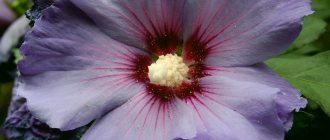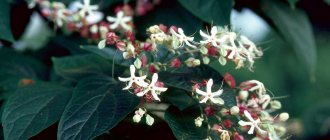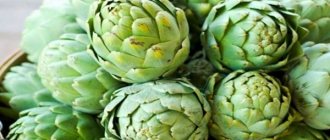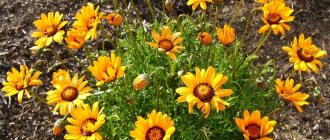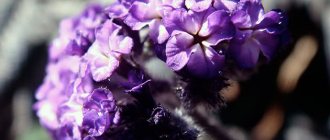In this article we will introduce you to the herbaceous, beautifully flowering plant Cineraria, which is often grown as an annual in open ground. But some of its species can be grown in residential premises on windowsills. Under favorable conditions, it decorates gardeners' homes not only with beautiful leaves, but also with bright inflorescences. Next, we will tell you about the rules for planting Indoor Cineraria and how to care for it at home.
Description
Cineraria is part of the Aster family (Latin: Asteráceae) or Compositae (Latin: Compositae). It is characterized by the complex structure of the flower, which actually represents a whole inflorescence - a basket consisting of small flowers tightly adjacent to each other.
Cineraria is native to the Canary Islands. The bulk grows in Madagascar, but can be found throughout tropical Africa in the form of perennial flowering herbaceous or semi-shrub plants.
The height of the plant ranges from 30 cm to 90 cm. Its erect shoots are prone to branching. A well-developed rhizome is formed in the form of a rod that goes deep into the soil. Large leaves on petioles grow on long stems. The shape of the leaves can be different: oval, lyre-shaped, pinnate and dissected. The leaf surface is evenly dotted with gray-silver hairs, which is why cineraria got its name (translated as ash).
The edges of the leaves are serrated. The leaf size reaches 10 cm, sometimes longer. The color of the leaves is often dark green, with a silvery tint. The leaves are attached to the branches using petioles. At the ends of the shoots, lush inflorescences form in the form of simple or terry baskets. Their core is lush, voluminous, with tubular multi-colored reed petals. Different varieties differ in color. Initially, the natural color of Cineraria petals was scarlet. Now breeders have developed varieties whose inflorescences are painted in rich colors of all shades of the rainbow. More often than others, there are specimens with blue or pink petals, the color of which gradually turns into snow-white closer to the center.
Flowering of Cineraria begins 6 - 8 months after its sowing. A flower can begin to bloom at any time of the year if favorable conditions are met. Basket-shaped inflorescences bloom at the tops of the shoots and show off there for a month. After flowering, a fruit is formed in the form of an oblong capsule with coal-black small oblong-shaped seeds.
Benefit
This bright flower not only decorates your home with its attractive appearance, but also purifies the indoor air from harmful and dangerous compounds. This is especially important for gardeners who suffer from asthma or allergies.
Indoor cineraria is an ideal gift for a woman on March 8th. I would be very happy to receive as a gift a compact bush with a lush head of lilac or violet (white, pink, blue) flowers. Even without special care, this bloom will last almost a month!
Indoor Cineraria also improves the indoor microclimate. It saturates the surrounding air not only with oxygen, but also with ozone, air ions, and volatile phytoorganic substances, which helps improve the general condition of the body of the person living with it.
By the way, they say that if you make a wish while the first Cineraria bud is blooming, it will definitely come true.
Description of the plant
Cineraria are perennial herbs or subshrubs with erect, highly branched shoots. The height of the vegetation is 30-90 cm. The plant is nourished by a thick tap root, which goes deep into the soil.
Large petiolate leaves of lyre-shaped, oval or pinnately dissected shape grow along the entire length of the stems. The surface of the shoots and leaves is densely covered with short, soft, bluish-silver hair. The leaves are quite large and form a continuous soft turf.
In mid-June, basket inflorescences bloom at the tops of the shoots. They can be simple or terry. Along the outer edge grow several rows of reed flowers in red, white, yellow or purple. The lush heart with tubular flowers is not limited to one color, it can be yellow, silver, blue or purple.
Replacing each other, the inflorescences of cineraria bloom until mid-autumn, until frost sets in. After pollination, dry seed pods ripen, inside of which there are small oblong seeds of a dark brown, almost black color.
Types and varieties
There are about 50 plant species in the genus Cineraria. Breeders have long been working on developing new hybrid varieties of Cineraria. And for good reason. Many beautiful varieties have been created that differ in the color of the inflorescences, their sizes, and, as a rule, the height of the bush itself. Small-flowered hybrids have been bred, the inflorescences of which cover the entire plant with a continuous cap of spectacular flowers. Large-flowered hybrids with large inflorescences attached to a branched peduncle are also highly valued. Let us introduce you to the most popular types.
Bloody
Cineraria "Bloody" (Cineraria cruentus). Photo: www.flowerpictures.org
This species is most often successfully grown indoors. It is often called “Room Cineraria”. Its erect, highly branched stems reach a height of 70 cm. They are covered with bright green openwork or oval foliage. In June, the bush begins to put on buds, and soon the foliage is hidden under a thick canopy of bright flowers of a wide variety of colors. The basket inflorescences are red, purple, lilac, white, blue - it’s impossible to list all the colors. It seems there are only yellow ones. Petals can be one-color or two-color. Inflorescences last about 4 weeks. Replacing each other, they bloom until frost, and in indoor conditions they can even please their mistress on March 8th.
Popular Bloody varieties
Cineraria Double is a bush from 35 to 60 cm in height with large flowers up to 5 cm in diameter, with petals of contrasting two-color colors.
Grandiflora
Cineraria Grandiflora is a subshrub about 50 cm in height. Needs support. It blooms in large simple basket-shaped inflorescences, from 5 to 8 cm in diameter. Its petals have a white base and a bright colored edge.
Stellata
Cineraria Stellata (Stellata) is a shoot up to 90 cm high with small and unusual star-shaped inflorescences - baskets from 2.5 to 4 cm in diameter, forming a spreading crown. Petals are tapered indigo colors.
Sympathy
Cineraria Sympathia is a tall variety, up to 70 cm in height. The bush is compact. The leaves are heart-shaped, light green, slightly hairy. Large flowers reach a diameter of 8 cm. They are monochromatic or bicolor. The coloring is very different. Flowering duration is from 4 to 6 weeks.
This may be interesting: Streptocarpus - growing and care at home
Venice
"Venice". This hybrid Cineraria is very popular. There is a whole series of varieties with all sorts of colors of inflorescences. It has a short growing period. Suitable for indoor cultivation in pots from 10 to 15 cm in diameter.
Primorskaya
Its other names: Silver, Sea, Ashy ragwort.
Seaside Cineraria (Cineraria maritima)
Perhaps this is the best decorative look, suitable for open ground. But, in frosty winters, it is grown in gardens as an annual crop. If you grow it in flowerpots, boxes, hanging baskets or other containers, then at the end of summer you can move your silver bushes indoors, where you arrange or hang them in the most convenient places - on a windowsill, on a closed veranda, loggia or in winter garden.
Cineraria Primorskaya is grown indoors as a perennial ornamental foliage plant. Indeed, in indoor conditions it blooms extremely rarely, and its flowers are not attractive; they are removed. It is grown exclusively for the beauty of its openwork silvery leaves. Bushes are easy to shape with regular pruning. Bright green leaf blades, thickened and segmented, completely covered with villi. The leaves on the stems are collected in elastic rosettes. Thanks to the original white and silver coloring of its feathery leaves, Primorskaya Cineraria is used in the design of flower beds, borders, and as a background plant. The pubescent leaf blades of complex shape create an original carpet, against which the bright flowers of neighbors in a pot, flower bed or lawn look amazing.
Popular subspecies of Primorskaya
Cirrus
Cineraria Cirrus (Cirrus) is a tall, dense bush with bright, round, but elongated serrated leaves of a silver-green hue. The leaves will acquire a silvery-white color only over time.
Silver dust or Silver Dust
Silver dust is a low-growing shrub, up to 25 cm in height, with surprisingly openwork leaves of a silvery hue.
Diamond Powder
Diamond powder is another low-growing variety, up to 20 cm high. It has carved, silver-ashy leaves.
Graceful
Graceful
This is the most unpretentious plant of the Cineraria genus. Its stems branch strongly and form an almost spherical shrub up to 60 cm high. The fleecy leaf plates are slightly sticky to the touch. During flowering, the plant is strewn with graceful, bright pink buds. Inflorescences, in the form of simple or double baskets, grow and are grouped into a continuous corymbose inflorescence on a single stem.
This type of Cineraria is only slightly inferior to its relatives in decorativeness, but its ease of cultivation and very long flowering attract lovers of indoor and garden flowers.
Nana (Multiflora Nana)
Nana (Multiflora Nana) is the most popular ornamental variety of Cineraria Graceful. A small compact bush, from 20 to 35 cm in height. Doesn't need support. The inflorescences consist of large pink flowers resembling stars with blood-red centers.
Botanical description of cineraria
The name of this plant means “ashy” in Latin. Various species and varieties of cineraria can be both subshrubs and herbaceous plants. Under natural conditions, the largest number of varieties of cineraria grows in Madagascar, as well as in the tropics of the African continent. But among indoor plants, only one species grows - bloody cineraria (or hybrid cineraria), although in fact we are talking about hybrid ragus. In garden plots, such flowers are grown as annuals or biennials.
The height of such garden flowers varies from 0.3 to 0.9 m, the stems are erect, their side shoots grow well over the season, the foliage is large, large, petiolate, their shape is lyre-shaped or oval. Many varieties have pinnately dissected foliage. Shoots and foliage are pubescent.
The inflorescences appear at the ends of the shoots, they consist of simple or double baskets, and the flowers are red, white, purple or yellow in color, and their core consists of small tubular flowers of a yellow hue. The first buds of these annuals appear in the second ten days of June. And the last flowers wither after the onset of frost on the soil.
How to choose Cineraria in a flower shop
If you decide to purchase a ready-made flowering Cineraria bush in a store, take it seriously. Carefully examine the plants you like. Assess their appearance and the condition of the shoots and leaves. Pay attention to the number of buds and already opened flowers. Choose the one with many more buds than blooming flowers. If you have the slightest suspicion of any disease, the presence of insects, limp leaves or wilted inflorescences, refuse to purchase.
Cineraria care
Rules of care
Caring for cineraria is simple; the main thing is properly organized watering. If the plant lacks moisture, it weakens; if there is too much moisture, the roots of the cineraria rot. But almost all types of cineraria are drought-resistant, and in principle, natural precipitation is enough for them. After rain or watering, you need to remove weeds from the area and loosen the soil. Immediately remove faded flowers, this will extend the flowering period of cineraria.
- Spiraea Wangutta: planting and care, description of varieties
Feed cineraria two to three times a month with mineral fertilizers. Decorative flowering species during the budding period are fed alternately with organic and mineral fertilizers every week. In decorative deciduous species of cineraria, the buds are cut off immediately after appearance, so that the plant does not waste energy and nutrition on them. That's all you need to know about caring for cineraria.
Home care
Lighting and location
The flower needs an abundance of sunlight, and diffused light, since direct sunlight will not do it any good. The pot should be placed on a bright and warm window sill, preferably in an eastern or western direction. On southern windows, the flower will have to be shaded with a light curtain or blinds. In northern areas, the plant will not have enough lighting and will need constant lighting. In the summer, you should not keep Cineraria in captivity at home - whenever possible, move it to a balcony, veranda or garden, where there is fresh air and coolness.
Temperature
Cineraria does not tolerate heat. It grows and develops well at an air temperature of 10 - 15 degrees, in extreme cases - no higher than 20 degrees. During flowering in winter, the flower can live on an unheated closed balcony or loggia, where the temperature does not drop below 5 degrees. heat. The higher the ambient temperature, the faster the plant will bloom. In summer, the pot should be taken out into the open air and kept somewhere in cool partial shade near a pond or at least a bucket of water. In autumn, a flower pot should be brought into the house. You need to find a place in the apartment where the plant will not be hot. For example, near the air conditioner, just so that the flow of cold air does not hit the flower. After all, Cineraria cannot tolerate drafts just like heat.
This may be interesting: Violet or Saintpaulia - home care
Watering
For watering, it is important to follow the so-called “golden mean” - not to dry out or over-moisten the soil. Water should be poured at the root so that its drops do not fall on the pubescent leaves and flowers of the plant. You can only use soft, well-settled water slightly warmer than room temperature. Make sure that watering is regular and the soil is slightly moist. After watering, it is advisable to loosen the top layer of soil so that its compaction does not interfere with the full supply of moisture and oxygen to the roots of the plant.
Humidity
The plant loves high ambient humidity, but does not tolerate spraying. Therefore, you will have to think about how to humidify the dry air of a city apartment in other ways. We can offer the following options: wet towels on heating devices (radiators), containers with water near a flower, household humidifiers, trays with wet expanded clay, etc. Among other things, indoor Cineraria does not tolerate stagnant air, so the room should be regularly ventilated, while protecting the flower from drafts. It will be better if you move the pot away from the windowsill before opening the window.
The soil
For Cineraria, only loose and nutritious soil with a slightly acidic or neutral reaction is suitable. For example, a mixture of 2 parts of peat and 1 part of compost with the addition of pieces of pine bark and charcoal in equal parts, which will promote good air permeability of the soil and protect the roots from all kinds of infections.
Pot
The plant has a voluminous root system. Therefore, it requires a fairly spacious pot, especially for an adult specimen. Check to see if there are drainage holes at the bottom of the pot. If they are not there, make the holes yourself using an awl or other tool heated on a gas burner. This is a necessary condition for growing Cineraria, since its roots do not tolerate flooding.
If, to maintain high humidity near the flower, you place the pot in a deep tray with wet pebbles or expanded clay, make sure that the bottom of the pot rests on the stones and does not touch the water.
Top dressing
If you have well-chosen soil and you grow Cineraria as an annual, then the flower will not require additional feeding. Otherwise, if the flower has been living with you for more than a year without replanting, then its soil is probably depleted. Therefore, during the flowering period it should be fed with complex mineral fertilizers in liquid form a couple of times a month. You will immediately see that the head of flowers will become more magnificent and brighter. Combine fertilizing with the next watering, applying fertilizer a few minutes after watering.
Agricola is a good fertilizer for indoor ornamental flowering plants. It is available in different forms. For example, in the form of sticks stuck into the soil. Under the influence of soil moisture, the root system of the plant is nourished with the necessary macro- and microelements. These sticks also protect the roots from rotting and harmful insects.
"Agricola" in liquid form. This fertilizer should be added to the water when watering. This is a good growth stimulator that saturates the soil with elements beneficial to the plant. Improves the immunity of the flower, stimulates it to form buds and bloom lushly.
Transfer
After purchasing a flowering bush, it should not be transplanted into another pot. Let it bloom. Some gardeners purchase Cineraria exclusively for one-time use - after flowering the bush is thrown away. If you want the flower to bloom again, remove faded inflorescences and shorten shoots that are too elongated. After this, transplant the plants into another pot, slightly larger in size.
To do this, remove the faded bush from the old pot along with the earthen lump. Place a drainage layer of expanded clay or pebbles in the new pot, then a layer of new suitable soil. Now place a lump of soil from your bush in the center of the pot, and fill all the voids around the edges and on top of the roots with substrate. Shake the pot slightly and water. If necessary, add more soil.
Trimming
The flower does not require special pruning to form a compact crown. Its shoots are quite branched, flower inflorescences are formed precisely at the tops. To maintain an attractive appearance, simply remove dried inflorescences and leaves. In addition, this will prolong flowering for some time.
Bloom
The leaves of this plant are decorative at any time of the year. But you can achieve flowering at will. It should be taken into account that about 8 - 9 months should pass between sowing the seeds and the beginning of flowering. This is for indoor specimens. In open ground, the seeds are sown in early April; in the fall it will begin to form buds, and will bloom in the winter, at home, if you dig it up and replant it in a pot.
If Cineraria does not bloom during the expected period, it may need stimulation - the temperature of its content should be lowered to 10-15 degrees. for a couple of months. Then start raising the temperature to 20 degrees and pouring plenty of warm water. We are sure that soon your beauty will be covered with a flower cap.
This may be interesting: Why anthurium (male happiness) does not bloom
Planting and caring for cineraria
- Planting: sowing seeds for seedlings in early April, planting seedlings in open ground in mid-May.
- Flowering: from mid-June until frost.
- Lighting: bright light in the morning and partial shade in the afternoon.
- Soil: fertile, well-drained, neutral or slightly alkaline.
- Watering: abundant, regular.
- Fertilizing: 2 times a month with complex mineral fertilizers.
- Reproduction: flowering species - by seed, decorative foliage - by seeds and cuttings.
- Pests: aphids, spider mites.
- Diseases: powdery mildew, rust.
Read more about growing cineraria below.
Cineraria (lat. Cineraria) is the name of the genus of the Aster family, or Asteraceae. Among the species of cineraria used in ornamental gardening, there are both representatives of this genus and species that belong to the genus of ragworts (lat. Senecio), close to cineraria, of the ragwort tribe of the same family Asteraceae. There are about fifty representatives of the genus Cineraria in nature; according to various sources, there are from one to three thousand species of ragworts. In this article we will talk about the most popular types of both cineraria and ragworts used in ornamental gardening. So, cineraria flowers...
- Ceropegia: cultivation and care
Reproduction of Cineraria by seeds
There are different ways to propagate a flower: using cuttings, layering and using seeds. But Cineraria Bloody or Potted Cineraria is not propagated by cuttings - only by seeds. We will consider this method of reproduction in more detail.
All ornamental flowering varieties of Cineraria are propagated in this way. The seeds germinate quickly and easily without any preliminary preparation in 10 - 14 days. Prepare suitable trays or containers with a lid. Add a layer of peat substrate (or purchased universal soil) and river sand and moisten it. Distribute the seeds evenly over the surface of the substrate, carefully press them to the surface and lightly sprinkle with sand. Cover the tray with film (container lid) to create greenhouse conditions for the seeds. Place the greenhouse in a bright, warm (about 22 degrees) place. Regularly moisten the substrate using a fine spray bottle with warm, settled water. The soil should not be allowed to dry out.
In two weeks the seeds should appear. It is very important that there is at least 12 hours of daylight. If seedlings begin to appear in winter, provide illumination using a fluorescent lamp or phytolamp. Start accustoming the sprouts to fresh air - first open the greenhouse for a while, and after a few days - remove the shelter completely. At this time, it is important to thin out the seedlings so that the distance between the sprouts is at least three cm.
It is important that the root system of each sprout is formed correctly. When your sprouts have at least three true leaves, you can start transplanting them into their own small pots. Now the bushes need coolness (15 - 18 degrees) and a lot of diffused sunlight.
Sometimes, to create greater splendor of the future flower, two or three seedlings are planted in a pot together. One thing to keep in mind is that they will consume three times as much water and nutrients. The root system will soon fill the small pot, and a new transplant will be required.
Bushes at the age of 5 - 6 months should be in small pots with drainage and drainage holes.
When to plant seeds
Sowing seeds can be done at any time of the year. From planting to flowering it will take at least 6-9 months. Therefore, if you need a blooming Cineraria by March 8, then you should plant it no later than July of the previous year. When sown in December, flowering can be expected closer to autumn.
If you have a summer house or garden plot, then the most suitable time for sowing seeds is mid-spring. During this period, daylight hours increase, there is no summer heat yet, and the seedlings that have sprouted and grown slightly in the home greenhouse can be transplanted into open ground, where they will grow well until autumn. In September, Cineraria will need to be carefully dug out of the ground along with its root system, transplanted into pots and left in the open air. If the bush has grown too much, divide it.
Now all you have to do is wait for the plant to begin to form buds. When frost approaches, move the Cineraria pots indoors. Choose a cool place, about 15 degrees. heat. This could be a loggia or a glazed balcony. By the New Year, even a little earlier, you will admire the magnificent blooms, which will last for more than a month.
Planting cineraria
When to plant
Growing cineraria is not particularly troublesome, but the more information you have, the easier it will be for you. So, what are cineraria's preferences? The lighting is preferably bright, but with shading at midday. She needs fertile and well-drained soil, slightly alkaline or neutral. If you have found a suitable site and brought the soil to the required pH value, then wait until mid-May, when sudden night frosts are behind you, and begin transplanting the seedlings into open ground.
How to plant
Planting cineraria is carried out according to the usual principle: in holes dug at a distance of 20-25 cm from each other, cineraria seedlings are planted along with the soil in which it grew. After planting, tamp down the soil and water the area. If you have a feeling that frost may return, cover the planting of cineraria overnight with spunbond or lutrasil for the required time.
Diseases
Indoor Cineraria is a favorite treat for many pests and fungi. Its susceptibility to disease is one of the reasons why many gardeners refuse to grow it as a perennial, but prefer to throw it away after flowering.
We will introduce you to the most common diseases of Cineraria and methods of treatment.
| Disease | Symptoms | Causes | Treatment |
| Gray rot | Fluffy ash-gray spots appear on the leaves. | Inaccurate watering of the plant - water gets on the leaves and stems. In a cool room with high air humidity, infection with gray mold is quite possible. | Remove the affected parts of the plant, transplant the bush into a new pot with fresh soil and treat with special anti-rot preparations containing copper. |
| Alternaria. Rust. Oidium. Late blight. Powdery mildew. | Spots of different colors appear on the leaves: light brown, gray with a dark border, or orange pustules. | Excessive watering, cold water, stagnation of water in the pan, wet heavy soil, keeping the flower in a damp, poorly ventilated area. | Treatment with special antifungal drugs. We recommend the drug “Topaz” and similar copper-containing fungicides |
| Cineraria does not bloom. | Gross violation of watering rules, low lighting, high temperature, large pot. | It is necessary to determine which of the reasons is yours and correct the situation. | |
| The leaves began to wither and turn yellow. | Insufficient watering, hypothermia. | In winter, move the bush away from the cold glass, do not allow the soil to become waterlogged, and adjust the temperature and humidity levels. | |
| The stems began to stretch. | Lack of lighting. | Move the flower to a more illuminated place. |
Growing from seeds and seedlings
Cineraria can be grown both from seeds and from seedlings. If you decide to resort to the first option, then the first thing you need to do is buy flower seeds. There will be no difficulties with this, since cineraria seeds are sold in almost all stores. I would like to emphasize that the germination rate of the seeds is quite high and it is easy to get seedlings from them, you just need to know how to care for cineraria, but more on that a little later.
It is recommended to sow seeds in April; choose a deep and wide container. The plant should be planted in a sand/peat mixture in equal parts. After sowing, the soil must be carefully watered with a sprayer and covered with film or even glass to create a greenhouse effect - this is exactly how growing a flower will lead to the desired result.
If you decide to resort to the second option (buying seedlings), then you should pay attention that the plant must have two true leaves, only such a seedling will take root well and grow strong and beautiful. It is not recommended to store seedlings in pots until spring; it is advisable to transplant them into peat briquettes, which can later be planted directly in open ground. If you do everything correctly, the plant will delight you with beautiful flowers. If you decide to keep the plant indoors, then you must choose a place for it that is sunny and warm, then the flower will show its beauty 100%.
Photo gallery
Cineraria in landscape design
Compact and bright cineraria is often used to decorate the border or front tier of a flower garden. Silver cineraria is planted against the background of brighter flowering plants in the form of a decorative border on the ground, as well as in crevices of rocky masonry.
Flowering varieties very effectively decorate the balcony and veranda. You can use them in a mixed flower garden. The variety of colors and shapes of inflorescences allows you to choose the sample you like or create a whole mix from cineraria alone. The best partners for her will be lobelias, petunias, phlox, sage and marigolds.
There are frequent cases of using inflorescences when making bouquets. A branch with several bright flowers looks great in a vase and does not wither for a long time.
Conditions necessary for cineraria
The following content rules must be observed:
| Factor | Conditions |
| Location | Choose the lightest one. Shade during midday heat. They can cause burns to greenery. This will cause brown spots. |
| Temperature | Optimal - +15...+18 °C. At +20 °C and above, the greens will wither. At night, the plant tolerates temperatures down to +5 °C. If cineraria grows at home, then from April to October keep it on a loggia, terrace, or in a constantly ventilated room. |
| Priming | When planting in the garden, first dig up the soil, adding peat, compost and sand. Indoor specimens should be planted in medium-sized containers filled with peat and deciduous soil, and compost. For both types of cultivation, it is recommended to add pieces of coniferous bark and wood ash to the substrate to prevent infections. |
| Humidity | High, but you can’t spray the bush because of the lint. You can place a basin with moistened moss in the room. Outside, water the soil generously without flooding the rhizome. |
| Watering | Abundant, but avoid stagnation of liquid. After moistening, loosen the soil, breaking up the hard crust. |
| Feeding | Regular, especially when the flower is planted on a poor substrate. Add mineral mixtures a couple of times a month. In spring - nitrogen-containing fertilizers to build up beautiful green mass. In summer - phosphorus compounds for better flowering. Change minerals to organic matter (mullein) several times a season. Feed indoor specimens once every 7 days. |
| Trimming | After wilting, trim off the inflorescences. Shorten branches growing in the wrong direction. |
Growing Cineraria
Planting can be done directly outside or into seedlings. The second method is preferable; in this case, flowering will last longer.
Growing cineraria through seedlings
Typically, seeds for propagation are purchased at a flower shop. They have good germination. Self-collection of seed material is rare, because the plant is rarely found in Russian gardens.
Sowing is carried out in the first half of April:
- Pour peat and sand (1:1) into the container.
- Distribute the seeds without burying them in the ground.
- Use a wooden ruler to compact the soil.
- Moisten the seedlings using a spray bottle with a fine nozzle or through bottom watering.
- Cover with glass or plastic film to create greenhouse conditions. Remove the cover every day to ventilate, water and remove evaporation from the walls.
- The first shoots will appear after 7-10 days. After this, move the containers to the brightest room.
- After the formation of 2 true leaves, dig the sprouts with a lump of earth into separate cups, preferably into peat-humus briquettes.
Soil for growing cineraria seedlings
Fertile, loose and light soil would be ideal.
Any store-bought, universal “for seedlings” type will do. If it seems a little dense to you, then add “baking powder” - sand, peat, perlite or vermiculite.
Large chips or compacted dense pieces of the mixture are sometimes found in store-bought soil. Remove them by hand or sift them on a sieve with large holes. Many people like to make their own soil mixture. You need to take 2 parts garden soil, 1 part river sand or perlite and 1 part peat. Before planting, the soil must be disinfected. Sprinkle with potassium permanganate or heat in the oven.
Choosing a container for growing cineraria seedlings from seeds
Primary sowing is best done in a flat and not deep container. The ideal depth would be 7–10 cm. You can use a special purchased container for planting cineraria seedlings. Or you can plant it in a regular plastic food container.
You can immediately sow 1-2 seeds in plastic cups or special cassettes. It is recommended to first sow in a common container and then pick. Here is the case when seedlings grow better when they are densely planted, next to each other.
Photo: It is recommended to first sow in a common container and then pick.
Containers must have drainage holes. If there are none, we make them using scissors, a heated nail or other tools.
Cineraria in winter
Cineraria is classified as a perennial plant, but in the climatic conditions of central Russia, the flower overwinters extremely poorly and often freezes, despite diligent care. That is why cineraria began to be grown as an annual rather than a winter plant. With the onset of cold weather, when the plant fades, all vegetation is destroyed and the soil is dug up.
If it’s a pity to part with your pet, then you can replant it in tubs or pots and keep it at home in winter. A room that is as bright as possible, but not too hot, is suitable for keeping. In the spring, the cineraria is again transplanted into open ground, again preparing the soil for planting.
In more southern regions, bushes winter well in open ground; to do this, they need to be wrapped in spruce branches and covered with fallen leaves on top.
Cineraria is a spectacular ash-colored plant that looks like small deer horns; it will not leave anyone indifferent. It looks advantageous both in open ground and when kept at home, so even novice gardeners can safely plant it. The variety of crop varieties allows each person to choose what he likes.




